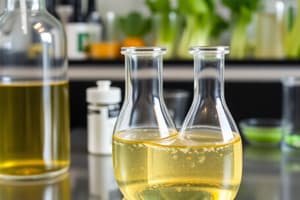Podcast
Questions and Answers
Where do the electrons come from in microbial metabolism?
Where do the electrons come from in microbial metabolism?
- Organic compounds
- Inorganic compounds
- Light activation
- All of the above (correct)
What is the ultimate terminal electron acceptor in metabolism?
What is the ultimate terminal electron acceptor in metabolism?
- Oxygen (correct)
- Carbon dioxide
- Lactic acid
- Ethanol
What is the most common source of carbon metabolism but not in phototrophs?
What is the most common source of carbon metabolism but not in phototrophs?
- Pyruvate
- Organic compounds
- Inorganic compounds
- Glucose (correct)
During metabolism, where are reduced electron carriers such as NADH generated?
During metabolism, where are reduced electron carriers such as NADH generated?
Where do the electrons go in the absence of oxygen or other terminal electron acceptor?
Where do the electrons go in the absence of oxygen or other terminal electron acceptor?
What type of phosphorylation occurs during glycolysis?
What type of phosphorylation occurs during glycolysis?
What can be produced from pyruvate in fermentation?
What can be produced from pyruvate in fermentation?
What are the main fermentation products mentioned in the text?
What are the main fermentation products mentioned in the text?
What is the utility of lactic acid in food production?
What is the utility of lactic acid in food production?
What specific fermentation product is mentioned in relation to Saccharomyces?
What specific fermentation product is mentioned in relation to Saccharomyces?
Which of the following is true about Lactobacillus?
Which of the following is true about Lactobacillus?
Which bacteria is responsible for the fermentation of milk into cheese?
Which bacteria is responsible for the fermentation of milk into cheese?
Which bacteria is responsible for the tangy flavor in sausages?
Which bacteria is responsible for the tangy flavor in sausages?
Which bacteria is added to curd to produce blue cheese?
Which bacteria is added to curd to produce blue cheese?
Which bacteria is responsible for the production of proprionic acid and CO2 in Swiss cheese?
Which bacteria is responsible for the production of proprionic acid and CO2 in Swiss cheese?
What accompanies the acid production during the fermentation of sauerkraut?
What accompanies the acid production during the fermentation of sauerkraut?
Which bacteria succeeds Leuconostoc during the fermentation of sauerkraut?
Which bacteria succeeds Leuconostoc during the fermentation of sauerkraut?
Which bacteria are homofermentative?
Which bacteria are homofermentative?
Which of the following is the final electron acceptor in fermentation?
Which of the following is the final electron acceptor in fermentation?
During fermentation, how many ATP molecules are produced for each molecule of glucose?
During fermentation, how many ATP molecules are produced for each molecule of glucose?
What happens to the excess NADH produced during fermentation?
What happens to the excess NADH produced during fermentation?
What is the main energy generation process in fermentation?
What is the main energy generation process in fermentation?
What is the final step in yeast fermentation of glucose to ethanol?
What is the final step in yeast fermentation of glucose to ethanol?
What is the organism responsible for most vaginal yeast infections?
What is the organism responsible for most vaginal yeast infections?
What may cause a change in the normal balance of yeast cells in the vagina, leading to a yeast infection?
What may cause a change in the normal balance of yeast cells in the vagina, leading to a yeast infection?
What is the temperature at which Candida albicans grows as a harmless commensal?
What is the temperature at which Candida albicans grows as a harmless commensal?
What can enhance the adhesion of Candida albicans to denture resin?
What can enhance the adhesion of Candida albicans to denture resin?
Mixed fermentation is a characteristic of which taxonomic group?
Mixed fermentation is a characteristic of which taxonomic group?
Which of the following is responsible for the distinctive flavour of Swiss cheese?
Which of the following is responsible for the distinctive flavour of Swiss cheese?
In anaerobic conditions, some cells can use fermentation to generate more glucose from glycolosis?
In anaerobic conditions, some cells can use fermentation to generate more glucose from glycolosis?
One difference between homofermenters and heterofermentors is that homofermentor:
One difference between homofermenters and heterofermentors is that homofermentor:
Flashcards are hidden until you start studying
Study Notes
Microbial Metabolism
- Electrons in microbial metabolism come from reduced electron carriers such as NADH, which are generated during glycolysis
- The ultimate terminal electron acceptor in metabolism is oxygen (in aerobic conditions) or other electron acceptors (in anaerobic conditions)
Carbon Metabolism
- The most common source of carbon metabolism, excluding phototrophs, is glucose
Fermentation
- In the absence of oxygen or other terminal electron acceptors, electrons are passed to organic molecules, resulting in fermentation
- Substrate-level phosphorylation occurs during glycolysis
- Pyruvate can be converted to lactic acid, ethanol, or other fermentation products
- Main fermentation products mentioned in the text include lactic acid, ethanol, and CO2
- Lactic acid is used in food production, such as in yogurt and sauerkraut
- Saccharomyces is associated with ethanol production
- Lactobacillus is involved in the fermentation of milk into cheese and is responsible for the tangy flavor in sausages
- Propionibacterium is responsible for the production of propionic acid and CO2 in Swiss cheese
Fermentation Microorganisms
- Leuconostoc is involved in the fermentation of sauerkraut, succeeded by Lactobacillus
- Homofermentative bacteria, such as Lactobacillus, produce lactic acid as the only or main fermentation product
- The final electron acceptor in fermentation is an organic molecule, such as pyruvate or acetaldehyde
- 2 ATP molecules are produced for each molecule of glucose during fermentation
- Excess NADH produced during fermentation is reoxidized to NAD+
Yeast Fermentation
- Candida albicans is the organism responsible for most vaginal yeast infections
- Changes in the normal balance of yeast cells in the vagina can lead to yeast infections
- Candida albicans grows as a harmless commensal at a temperature of 37°C
- Chitin enhances the adhesion of Candida albicans to denture resin
- The final step in yeast fermentation of glucose to ethanol is the reduction of acetaldehyde to ethanol
Mixed Fermentation
- Mixed fermentation is a characteristic of the Enterobacteriaceae taxonomic group
Studying That Suits You
Use AI to generate personalized quizzes and flashcards to suit your learning preferences.




